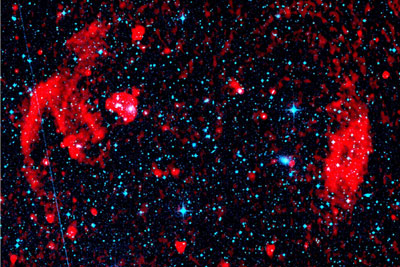Galaxy Cluster’s Ring Hints at Cosmic Shockwave

Aring-like formation around a distant cluster of galaxies has yielded what may be thefirst glimpse of a shockwave spawned by either a cosmic collision or interstellar gas.
Thering, made up radio signal-emitting arcs [image],surrounds a rich collection of galaxies known as Abell 3376. It appears to be atell-tale sign of the cluster’s growing pains from accreting gas ormergers on a galactic scale, a new study suggests.
“Wethink these radio [objects] are tracing out theshockwaves from large-scale structure formation,” said radio astronomerJoydeep Bagchi, a professor at Pune, India’s Inter-UniversityCentre for Astronomy and Astrophysics, who led the recent study.
Bagchiand his colleagues used the VeryLarge Array in Socorro, New Mexico to scan Abell 3376, where they found apair of immense radio arcs on the outer fringe of the cluster. The researchappears in the Nov. 3 issue of the journal Science.
Astronomershave known of such objects, previously dubbed “radio relics,” sincethe 1970s, but only recently associated their presence with shockwavesresulting from galaxycluster mergers, researchers said. Pinning down their source can helpastronomers understand the finer details of the evolution of large-scalestructures in the universe, they added.
Bagchitold SPACE.com that computermodel simulations of galaxy cluster mergers have consistently producedcosmic shockwaves, but the actual phenomenon has not been visible so clearly asseen around Abell 3376 [video].The cluster’s radio arc signals, he said, are indicative of high-energyparticles streaming outward at near the speed of light.
Thegalaxy cluster's radio arcs may also have stemmed from an accretion shockwavegenerated by colliding bits of interstellar gas as they fall under thecluster's gravitational spell. As the interstellar gas falls inward towards thecluster, it collides with the galactic group's own hot, ionized gas to formshockwaves, researchers said.
Get the Space.com Newsletter
Breaking space news, the latest updates on rocket launches, skywatching events and more!
“Accretionshock waves are very interesting because they may be the origin of thestill-mysterious ultra-high energy cosmic rays…,” wrote astronomerTorsten Ensslin, of the Max Planck Institute for Astrophysics in Germany, in a Perspectivesarticle related to Bagchi’s study in Science.
Theaccretion model would also call for the presence of magnetic fields on theouter fringe of a galaxy cluster, rather than their typical haunt at itscenter, setting the stage for the formation of high-energy particles, Bagchiadded.
“Sothere’s already all the ingredients of a cosmic particleaccelerator,” Bagchi said. “That is an exciting possibility forfuture research.”
Bagchiand his colleagues focused on the radio emissions of Abell 3367, but thedevelopment of more sensitive telescopes and space-based instruments—suchas NASA’s planned Gamma-rayLarge Area Space Telescope (GLAST) to launch next year—will peerdeeper into the source of high-energy particles.
“Thisis a very exciting result and there are a lot more to come, I believe,”Bagchi said. “It’s the beginning of [understanding] something thatis still hidden beyond our vision.”
- VIDEO:Simulated Shockwave Forms Rings Around Galaxy Cluster
- All About Galaxies
Join our Space Forums to keep talking space on the latest missions, night sky and more! And if you have a news tip, correction or comment, let us know at: community@space.com.

Tariq is the Editor-in-Chief of Space.com and joined the team in 2001, first as an intern and staff writer, and later as an editor. He covers human spaceflight, exploration and space science, as well as skywatching and entertainment. He became Space.com's Managing Editor in 2009 and Editor-in-Chief in 2019. Before joining Space.com, Tariq was a staff reporter for The Los Angeles Times covering education and city beats in La Habra, Fullerton and Huntington Beach. In October 2022, Tariq received the Harry Kolcum Award for excellence in space reporting from the National Space Club Florida Committee. He is also an Eagle Scout (yes, he has the Space Exploration merit badge) and went to Space Camp four times as a kid and a fifth time as an adult. He has journalism degrees from the University of Southern California and New York University. You can find Tariq at Space.com and as the co-host to the This Week In Space podcast with space historian Rod Pyle on the TWiT network. To see his latest project, you can follow Tariq on Twitter @tariqjmalik.









